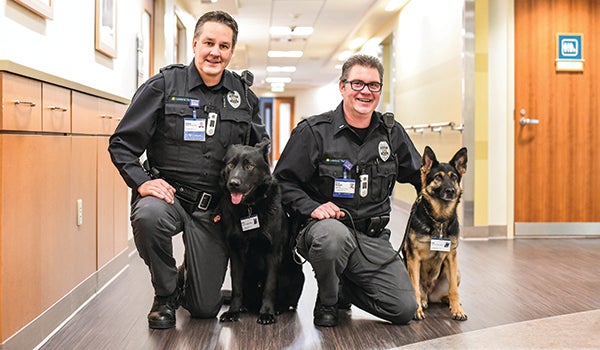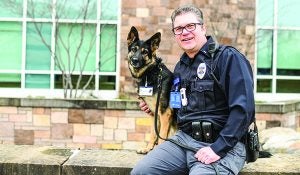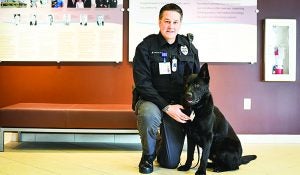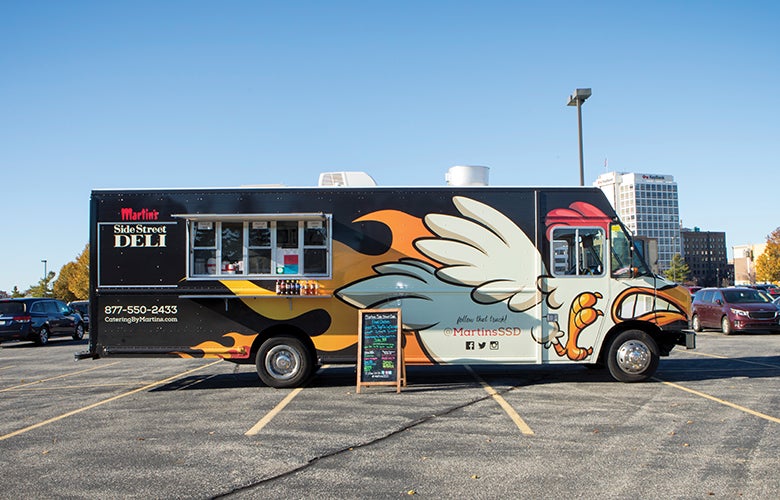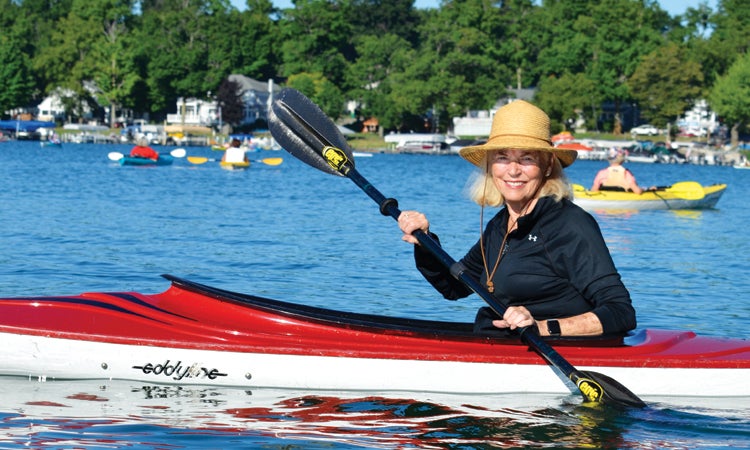ST. JOSEPH — Inez seemed distracted when she sat down to get her picture taken at a local hospital.
Perhaps it was the three nurses fawning over her, a 4-year-old German Shepherd, a few feet away. Perhaps it was the myriad of scents that wafted through Spectrum Health Lakeland’s St. Joseph campus.
Whatever the reason, getting pictures taken is an anomaly for Inez. When she is in a health facility, she is at work.
Inez is a K9 unit for Spectrum Health Lakeland. For the past two years, she has kept physicians, patients, staff and visitors safe. She sniffs out potentially dangerous objects, and she deters assaultive patients and visitors with her presence — and, sometimes, her force.
With her handler, Lieutenant Bruce Modigell, she protects Spectrum Health Lakeland’s facilities, from South Haven to Niles.
According to a 2017 U.S. News & World report, health care is the most dangerous profession in the nation. The study found that common workplace injuries arise from accidental needle sticks, body fluid exposure and back injuries.
But workplace violence was found to be on the rise in health care, too. The stress of sickness, injury and treatment can cause visitors and patients to respond physically and verbally to the nurses and physicians caring for them.
That was why Rich Matthews, director of safety and security for Spectrum Lakeland Health, worked to create a K9 program.
“We are very unique in that we, in health care, search for the non-lethal tools we can employ to help reduce violence, specifically disorderly conduct, assaults, verbal assaults,” he says.
Lakeland’s two K9s, Rich says, are the equivalent of tasers. Both are non-lethal and both their presences, not their use, are effective at making places safe. According to a National Institute of Health study, K9s in health care workplaces greatly reduce rates of violence.
“Their demeanor goes from 90 to 40 like that,” says Bruce, moving his hand from near his head to near his waist to indicate a drop in anger. “Nine times out of 10, when someone sees the dog, they know they’re done. They just have that effect on people.”
Rich says he has not only seen a decrease in assaults but also an anecdotal increase in happiness due to Lakeland’s K9s, Hiro and Inez, and their handlers.
Unlike a taser, K9s also offer comfort, says safety and security officer Chris Aungst. Whether upset, anxious or tranquil, people love seeing the K9s.
Chris was brought onto staff to handle Hiro, another German shepherd K9, a few weeks into the job.
The duo spends much of its time in the emergency rooms and the patient ward at Spectrum Health Lakeland’s St. Joseph hospital because they tend to have the highest rates of injury and violence. Staff hustling past will stop to beam at the dog. Patients will catch a glimpse of the 2.5-year-old pooch walking by and ask to see him up close.
Even when Chris and Hiro are called to deescalate a situation, those involved tend to warm up to the K9.
“Just you being there, listening, whether it’s my ears or his ears, that’s all they need,” Chris says. “Again, it goes back to comforting the patients and the visitors. They’re amazing, what they can get accomplished by themselves.”
When Hiro and Inez are not visiting patients, visitors and staff, they are roaming the various facilities of Spectrum Health Lakeland, using their noses to potentially find one of about 20 scents indicating dangerous objects, from firearms to explosives.
Chris says there is no “off switch” for the K9s — they are always on alert. It is the job of the handler to detect when their partners have a change in behavior that could indicate a dangerous object is present.
Then, the handler can “ramp that switch up” on their dogs to set the hunt afoot, Chris says.
Bruce flicked that switch in October 2019 when he and Inez were called into the Benton Harbor-St. Joseph YMCA after a bomb threat was called. Inez determined no explosive was present.
“It takes a lot of courage for one of these guys to take that dog and walk into a building where they say there might be a bomb there,” Rich says.
To prepare for situations like that at the YMCAs, the two dogs and their two handlers train at least 16 hours a week. The experience allows the handler-dog relationship to deepen while also building up endurance — K9s can become overwhelmed by all the scents a hospital offers.
The work is an extension of the training Inez and Hiro received at a K9 facility in central Indiana and that the dogs and their handlers received together before starting their new jobs.
Recently, Hiro and Chris trained to detect a firearm. A gun was buried in a large open field with 15 miles-an-hour winds. Hiro was on the hunt so quickly, Chris felt his hand burning from the unraveling of Hiro’s leash.
Working together as a team and learning each other’s behavior is difficult, says Chris, a retired Berrien County Sheriff’s Department deputy.
“If you think, ‘I’ve owned a dog, and I’m going to be a K9 handler, it’s all going to happen,’ you’re in for a rude awakening,” he says.
But Chris and Bruce both say they enjoy their jobs. They get to help people feel comfortable in a place no one wants to be in, and they get to keep those people safe from themselves or others.
Working with a dog is certainly a perk, too. Before heading inside for the evening, Chris and Hiro will unwind from a day’s work by playing fetch with a tennis ball.
Photography by Emily Sobecki

